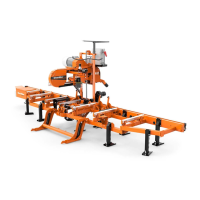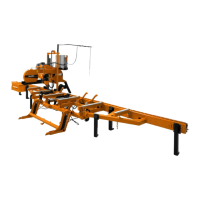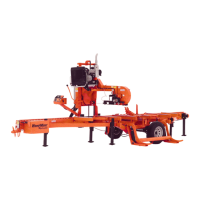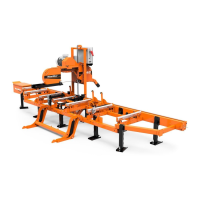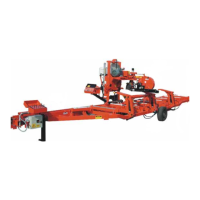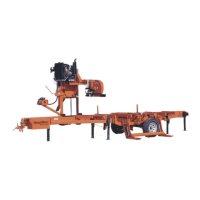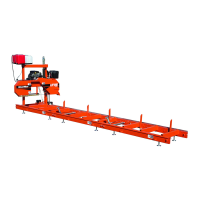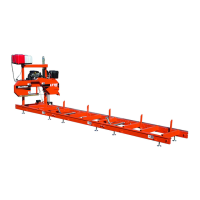
Do you have a question about the Wood-mizer LT40 B1 Series and is the answer not in the manual?
| Model | LT40 B1 Series |
|---|---|
| Log Length Capacity | 16' 8" (5.0 m) |
| Max Log Diameter | 36 inches (91 cm) |
| Blade Width | 1-1/4 inches (32 mm) |
| Fuel Type | Gasoline |
Identifies the locations of the Vehicle Identification Number on the sawmill.
Details the meaning of each digit in the Vehicle Identification Number.
Explains the components of the sawmill's model number for identification.
Provides contact details for Wood-Mizer service and support centers globally.
Lists Wood-Mizer authorized sales centers and headquarters worldwide.
Instructions and precautions for safely handling saw blades.
Procedures for setting up the sawmill correctly and safely.
Guidelines for the safe and efficient operation of the sawmill.
Procedures for maintaining the sawmill to ensure optimal performance and longevity.
Specifications for various drive belts used on the sawmill.
Information on different types and sizes of saw blades available.
Details the log size capacities and cutting specifications for LT40 models.
Specifications for the engines and motors powering the sawmill.
Information on the average noise levels produced by the sawmill.
Provides the physical dimensions of the LT40 B1-4 Series sawmills.
Lists the load capacity specifications for the sawmill chains.
Details the specifications of the sawmill's hydraulic system.
Technical specifications for the dust extraction system used with the sawmill.
Identifies and illustrates the major components of the LT40 B1-4 sawmill.
Lists and describes the specific parts for mounting LT40 sawmills.
Details the types and quantities of fasteners required for assembly.
Lists the required tools for assembling the sawmill.
Guidance on how to safely unpack the sawmill.
Instructions for unpacking and setting up the sawmill with remote operation features.
Step-by-step instructions for assembling the sawmill's bed frame.
Procedures and conditions required for setting up the sawmill.
Instructions for setting up sawmills that utilize outrigger legs for stability.
Procedures for setting up sawmills that incorporate a cable guide system.
Instructions for installing and maintaining the middle track cover.
Step-by-step guide for safely replacing the sawmill blade.
Procedures for correctly tensioning the sawmill blade using the gauge.
How to adjust the blade to ensure it tracks correctly on the wheels.
Instructions for starting the AC motor on the LT40 B1-4 sawmill.
Instructions for starting the DC engine on the LT40 B1-4 sawmill.
Procedures for safely loading, turning, and clamping logs onto the sawmill bed.
How to operate the up/down mechanism for adjusting the saw head height.
Instructions for adjusting and operating the blade guide arm.
How to operate the clutch and brake mechanism for engaging the blade.
How to use the power feed system to move the carriage.
Explanation of the blade height scale for setting cut depth.
Instructions for using the water lube system to keep the blade clean.
Estimated life expectancy of common replacement parts for the sawmill.
Procedures for inspecting, adjusting, and maintaining the blade guides.
Steps for removing sawdust buildup from various parts of the sawmill.
Maintenance procedures for the carriage track, wipers, and scrapers.
Cleaning and lubrication instructions for the vertical mast rails.
Lubrication procedures for the drum switch contacts within the control panel.
Various maintenance tasks including lubrication, alignment checks, and decal replacement.
Lubrication and adjustment of the blade tensioner system.
Procedures for adjusting and checking the brake strap for proper function.
Maintenance and replacement guidelines for the blade wheel belts.
How to check and adjust the tension of the drive belts on the sawmill.
How to adjust the clutch handle for proper engagement and locking.
Procedures for adjusting the Autoclutch option linkage and turnbuckle.
Refilling fluid in the drive-side cylinder bearing housing.
Lubrication and maintenance of the up/down gear reducer shaft bearing.
Adjusting the power feed belt tension and chain tension.
Procedures for inspecting E-STOP button, control circuits, and blade cover safety switches.
Solutions and causes for common problems encountered during sawing operations.
Troubleshooting steps for electrical issues affecting the sawmill's operation.
Diagnosing and resolving issues related to the power feed system.
Steps for aligning the motor and drive pulleys for optimal performance.
Performing tests to diagnose power feed system issues, including switch and mechanical checks.
Initial steps and checks required before performing detailed sawmill alignment.
Procedures for installing and aligning the saw blade on the sawmill wheels.
Adjusting the nylon pads on the saw head for proper alignment with the mast.
Procedures for adjusting the lower track rollers for accurate cutting.
How to adjust the bed rails to be parallel with the saw blade.
Steps to align the blade guide arms for optimal blade control.
How to achieve proper blade deflection using the blade guides.
Measuring and adjusting the vertical tilt of the blade guides.
Adjusting the spacing between the blade guide flange and the blade.
Adjusting the horizontal tilt of the blade guides.
Adjusting the gap between the blade guide disc and the blade.
Adjusting side supports to be square to the bed for ensuring square lumber.
Adjusting side supports to ensure they are vertical and properly positioned.
Compensating for saw head drop when cutting wide logs or cants.
Ensuring the blade height scale accurately shows the distance from blade to bed rails.
